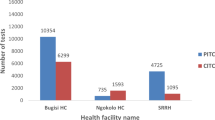Abstract
Background
Despite the high prevalence of HIV in adults (11 %) in Malawi, testing among surgical patients is not routine. We examined the feasibility of universal opt-out HIV testing and counseling (HTC) on the surgical wards of Kamuzu Central Hospital in Lilongwe, Malawi, and sought to further delineate the role of HIV in surgical presentation and outcome.
Methods
We reviewed HTC and surgical admission records from May to October 2011 and compared these data to data collected prospectively on patients admitted from November 2011 through April 2012, after universal HTC implementation.
Results
Prior to universal HTC, 270 of the 2,606 (10.4 %) surgical admissions were tested; 13 % were HIV-infected. After universal HTC implementation, HTC counselors reviewed 1,961 of the 2,488 admissions (79 %): 310 (16 %) had known status (157 seropositive, 153 seronegative) and 1,651 had unknown status (81 %). Among those with unknown status, 97 % (1,598, of 64 % of all admissions) accepted testing, of whom 9 % were found to be HIV-infected. Patients with longer lengths of stay (LOS) (mean = 11 vs. 5 days, p < 0.01) and those who underwent surgical intervention (odds ratio [OR] 2.5; confidence interval [CI] 2.0–3.1) were more likely to have a known status on discharge. HIV was more prevalence in patients with infection and genital/anal warts or ulcers and lower in trauma patients. HIV-positive patients received less surgical intervention (OR 0.69; CI 0.52–0.90), but there was no association between HIV status and length of stay or mortality.
Conclusions
Universal opt-out HTC on the surgical wards was well accepted and increased the proportion of patients tested. High HIV prevalence in this setting merits implementation of universal HTC.

Similar content being viewed by others
References
USAID (2011) HIV/AIDS Health Profile Southern Africa. Available at http://transition.usaid.gov/our_work/global_health/aids/Countries/africa/southernafrica_profile.pdf. Accessed 1 May 2013
Bowie C (2006) The burden of disease in Malawi. Malawi Med J 18(3):103–110
Harries AD, Makombe SD, Libamba E et al (2011) Why did the scale-up of HIV treatment work? A case example from Malawi. J Aquir Immune Defic Syndr 57:S64–S67
National Statistical Office (NSO) (Malawi) and ORC Macro (Calverton, MD, USA) (2001) Malawi Demographic and Health Survey 2000. Available at www.measuredhs.com/pubs/pdf/FR123/FR123.pdf. Accessed 6 May 2013
National Statistical Office (NSO) (Malawi) and ORC Macro (Calverton, MD, USA) (2011) Malawi Demographic and Health Survey 2010. Available at www.measuredhs.com/pubs/pdf/FR247/FR247.pdf. Accessed 6 May 2013
UNAIDS (2010) Malawi HIV and AIDS Monitoring and Evaluation Report 2008–2009. Available at http://www.unaids.org/en/dataanalysis/knowyourresponse/countryprogressreports/2010countries/malawi_2010_country_progress_report_en.pdf. Accessed 6 May 2013
Jahn A, Floyd S, Crampin AC et al (2008) Population-level effect of HIV on adult mortality and early evidence of reversal after introduction of antiretroviral therapy in Malawi. Lancet 371(9624):1603–1611
Malawi Ministry of Health (2009) Guidelines for HIV Testing and Counseling (HTC), 3rd ed. Available at http://www.hivunitmohmw.org/Main/HIVTesting. Accessed 6 May 2013
Lewis DK, Callaghan M, Phiri K et al (2003) Prevalence and indicators of HIV and AIDS among adults admitted to medical and surgical wards in Blantyre, Malawi. Trans R Soc Trop Med Hyg 97(1):91–96
Martinson NA, Omar T, Gray GE et al (2007) High rates of HIV in surgical patients in Soweto, South Africa: impact on resource utilisation and recommendations for HIV testing. Trans R Soc Trop Med Hyg 101(2):176–182
Cacala SR, Mafana E, Thomson SR et al (2006) Prevalence of HIV status and CD4 counts in a surgical cohort: their relationship to clinical outcome. Ann R Coll Surg Eng 88(1):46–51
Bhagwanjee S, Muckart D, Jeena PM et al (1997) Does HIV status influence the outcome of patients admitted to a surgical intensive care unit? A prospective double blind study. BMJ 314(7087):1081–1084
Madiba TE, Muckart DJ, Thomson SR (2009) Human immunodeficiency disease: how should it affect surgical decision making? World J Surg 33(5):899–909. doi:10.1007/s00268-009-9969-6
Horberg MA, Hurley LB, Klein DB et al (2006) Surgical outcomes in human immunodeficiency virus-infected patients in the era of highly active antiretroviral therapy. Arch Surg 141(12):1238–1245
Wakeman R, Johnson CD, Wastell C (1990) Surgical procedures in patients at risk of human immunodeficiency virus infection. J R Soc Med 83(5):315–318
Consten EC, Slors FJ, Noten HJ et al (1995) Anorectal surgery in human immunodeficiency virus-infected patients. Clinical outcome in relation to immune status. Dis Colon Rectum 38(11):1169–1175
Cohen MS, Chen YQ, McCauley M et al (2011) Prevention of HIV-1 infection with early antiretroviral therapy. N Engl J Med 365(6):493–505
Powers KA, Ghani AC, Miller WC et al (2011) The role of acute and early HIV infection in the spread of HIV and implications for transmission prevention strategies in Lilongwe, Malawi: a modelling study. Lancet 378(9787):256–268
Granich RM, Gilks CF, Dye C et al (2009) Universal voluntary HIV testing with immediate antiretroviral therapy as a strategy for elimination of HIV transmission: a mathematical model. Lancet 373(9657):48–57
Lin EY, Brunicardi FC (1994) HIV infection and surgeons. World J Surg 18(5):753–757. doi:10.1007/BF00298922
Consten EC, van Lanschot JJ, Henny PC et al (1995) A prospective study on the risk of exposure to HIV during surgery in Zambia. AIDS 9(6):585–588
McGowan DR, Norris JM, Smith MD et al (2012) Routine testing for HIV in patients undergoing elective surgery. Lancet 380(9846):e5
Olapade-Olaopa EO, Salami MA, Afolabi AO (2006) HIV/AIDS and the surgeon. Afr J Med Med Sci 35(Suppl):77–83
Author information
Authors and Affiliations
Corresponding author
Rights and permissions
About this article
Cite this article
Haac, B.E., Charles, A.G., Matoga, M. et al. HIV Testing and Epidemiology in a Hospital-Based Surgical Cohort in Malawi. World J Surg 37, 2122–2128 (2013). https://doi.org/10.1007/s00268-013-2096-4
Published:
Issue Date:
DOI: https://doi.org/10.1007/s00268-013-2096-4




